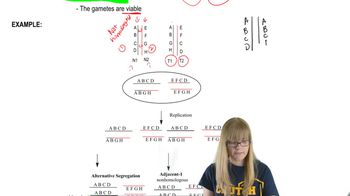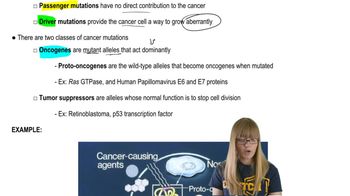Table of contents
- 1. Introduction to Genetics51m
- 2. Mendel's Laws of Inheritance3h 37m
- 3. Extensions to Mendelian Inheritance2h 41m
- 4. Genetic Mapping and Linkage2h 28m
- 5. Genetics of Bacteria and Viruses1h 21m
- 6. Chromosomal Variation1h 48m
- 7. DNA and Chromosome Structure56m
- 8. DNA Replication1h 10m
- 9. Mitosis and Meiosis1h 34m
- 10. Transcription1h 0m
- 11. Translation58m
- 12. Gene Regulation in Prokaryotes1h 19m
- 13. Gene Regulation in Eukaryotes44m
- 14. Genetic Control of Development44m
- 15. Genomes and Genomics1h 50m
- 16. Transposable Elements47m
- 17. Mutation, Repair, and Recombination1h 6m
- 18. Molecular Genetic Tools19m
- 19. Cancer Genetics29m
- 20. Quantitative Genetics1h 26m
- 21. Population Genetics50m
- 22. Evolutionary Genetics29m
19. Cancer Genetics
Overview of Cancer
Problem 15a
Textbook Question
Textbook QuestionHow do translocations such as the Philadelphia chromosome contribute to cancer?
 Verified Solution
Verified SolutionThis video solution was recommended by our tutors as helpful for the problem above
Video duration:
1mPlay a video:
Was this helpful?
Key Concepts
Here are the essential concepts you must grasp in order to answer the question correctly.
Translocation
Translocation is a genetic alteration where a segment of one chromosome breaks off and attaches to another chromosome. This can disrupt normal gene function and lead to the formation of fusion genes, which can produce abnormal proteins that drive uncontrolled cell growth, a hallmark of cancer.
Recommended video:
Guided course

Reciprocal Translocation
Philadelphia Chromosome
The Philadelphia chromosome is a specific genetic abnormality resulting from a translocation between chromosomes 9 and 22. This translocation creates the BCR-ABL fusion gene, which encodes a tyrosine kinase that promotes cell proliferation and inhibits apoptosis, contributing to the development of chronic myeloid leukemia (CML).
Recommended video:
Guided course

Chromosome Structure
Oncogenes
Oncogenes are mutated forms of normal genes (proto-oncogenes) that, when activated, can lead to cancer. The BCR-ABL fusion gene acts as an oncogene by continuously signaling cells to divide, bypassing the normal regulatory mechanisms, thus playing a critical role in the oncogenesis associated with the Philadelphia chromosome.
Recommended video:
Guided course

Cancer Mutations

 9:51m
9:51mWatch next
Master Cancer Characteristics with a bite sized video explanation from Kylia Goodner
Start learningRelated Videos
Related Practice



